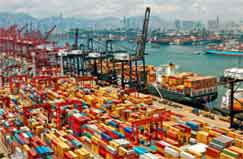Last week, the twin ports of Los Angeles and Long Beach announced new $100 fees for containers using what they will now classify as excessive dwell time before they are moved from terminals.
The Long Beach Board of Harbor Commissioners approved the “Container Excess Dwell Fee” by unanimous vote on Friday. The Port of Los Angeles’ board voted 4-0 to approve an identical measure.
Supply Chain Digest Says... |
 |
|
Container carrier CMA CGM said in a note to customers last week that called the fee a “government pass-through charge,” according to the Wall Street Journal. |
|
 |
|
What do you say? |
|
| Click here to send us your comments |
|
| |
|
| Click here to see reader feedback |
|
|
|
More specifically, in the case of containers scheduled to move by truck, ocean carriers will be charged for every container “dwelling” nine days or more, while for containers moving by rail, carriers will be charged if the container has dwelled for three days or more.
Another $100 per container per day will be charged if the boxes remain at the port – in exponential fashion. So for example for a container in its third day of excess dwell the charge reaches $600, then $1000 total on day 4, etc., according to a presentation by the Port of Long Beach.
If the container doesn’t move so by day seven, the charge would total $2,800.
Importers, it should be noted, already pay sometimes hefty demurrage fees. In fact, as SCDigest reported at the time, earlier this year the Biden administration asked the Federal Maritime Commission to investigate the practice and to ensure such charges are equitable.
The new charges began this week and are set to last for at least 90 days. The fees will start being assessed Nov. 15.
The new fees of course are meant to get containers moving and reduce the congestion that is contributing to record delays and backlogs at the ports.
However, the ports have the authority to not start charging the new fees, should there be progress by the November 15 assessment date.
Officials said currently about 40% of the containers in the terminals fall into one of the two categories.
But will the fees accomplish that objective? And who will ultimately bear the costs?
(See More Below)
|
CATEGORY SPONSOR: SOFTEON |
|
|
|
|
|
Many carrier contracts have a provision that allows for additional charges from marine terminals to be passed straight directly to the shipper or in some cases the freight forwarder and will thus be able to include the fee in their D&D invoices, payable before the containers are released.
 That even though importers and forwarders have little control over when most containers are moved away from the ports. That even though importers and forwarders have little control over when most containers are moved away from the ports.
“The customers can’t get the boxes off the dock because they can’t find [trucking] power, [or] the warehouse is full,” Craig Grossgart, senior vice president of global ocean for Seko Logistics, an Itasca, Ill.-based freight forwarder, told the Wall Street Journal.
But the container carriers don’t see it that way.
The World Shipping Council, a trade association for ocean carriers, says the fees amount to demurrage penalties on ocean carriers and “does not indicate an approach that can be expected to incentivize cargo owners to pick up their cargo from the ports.”
The Council added that “As described the fee is on the ocean carrier, but the control over when the cargo is to be picked up sits with the cargo recipient. Having the ocean carrier pay more does nothing to encourage the cargo interest to pick up the cargo; therefore, the incentive does not reach the party that needs to come to the to remove the long-dwelling cargo,” in a statement to the gCaptain web site last week.
Jonathan Gold, vice president for supply chain at the National Retail Federation, added that “We understand the need to push to get the cargo moving. But we are concerned about how the fee is going to be implemented and the fact that it’s going to get passed along.”
Container carrier CMA CGM said in a note to customers last week that called the fee a “government pass-through charge,” according to the Wall Street Journal.
So there is a lot of confusion.
In theory, reducing the number of containers stacked at the freight terminals should enable container ships to be unloaded more quickly, and to bring in additional empty containers that are causing major congestion at container yards close to the ports.
But we’ll just have to see if it works out that way in practice.
What do you think of the new container fees? Will it work? Who wil pay? Let us know your thoughts at the Feedback section below
Your Comments/Feedback
|

